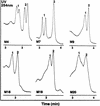Detection of numerous Y chromosome biallelic polymorphisms by denaturing high-performance liquid chromatography
- PMID: 9331370
- PMCID: PMC310671
- DOI: 10.1101/gr.7.10.996
Detection of numerous Y chromosome biallelic polymorphisms by denaturing high-performance liquid chromatography
Abstract
Y chromosome haplotypes are particularly useful in deciphering human evolutionary history because they accentuate the effects of drift, migration, and range expansion. Significant acceleration of Y biallelic marker discovery and subsequent typing involving heteroduplex detection has been achieved by implementing an innovative and cost-efficient method called denaturing high-performance liquid chromatography (DHPLC). The power of the method resides in its sensitivity and ability to rapidly compare amplified sequences in an automated manner. We have determined the allelic states of 22 Y polymorphisms; 19 of which are unreported, in 718 diverse extant chromosomes; established haplotype frequencies; and deduced a phylogeny. All major geographic regions, including Eurasia, are characterized by mutations reflecting episodes of genetic drift and expansion. Most biallelic markers are localized regionally. However, some show wider dispersal and designate older, core haplotypes. One transversion defines a major haplogroup that distinguishes a previously unknown deep, apparently non-African branch. It provides evidence of an ancient bottleneck event. It is now possible to anticipate the inevitable detailed reconstruction of human Y chromosome genealogy based on several tens to even hundreds of these important polymorphisms.
Figures


Comment in
-
Modeling human evolution--to tree or not to tree?Genome Res. 1997 Oct;7(10):947-9. doi: 10.1101/gr.7.10.947. Genome Res. 1997. PMID: 9331363 No abstract available.
References
-
- Casanova M, Leroy P, Boucekkine C, Weissenbach J, Bishop C, Fellous M, Purrello M, Fiori G, Siniscalco M. A human Y linked DNA polymorphism and its potential for estimating genetic and evolutionary distance. Science. 1985;230:1403–1406. - PubMed
Publication types
MeSH terms
Substances
Grants and funding
LinkOut - more resources
Full Text Sources
Other Literature Sources
